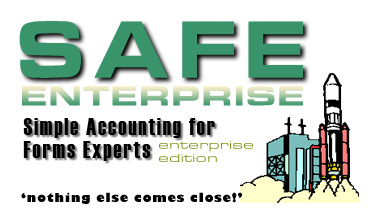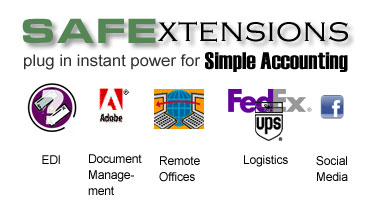Configuring SAFE EE
Now that you’ve got the program started, it’s important to configure the software to fit your company. There are a number of ways to start using this software. Most of your decisions will be based on if or when you wish to start using the G/L.
 When to Convert Your System to Simple Accounting You should probably plan on a two month period in which you use Simple Accounting and your old system side by side before working exclusively with Simple Accounting. Why? It takes time to develop the day-to-day routines necessary to run any accounting system. You really must use the new system for a period of time alongside your old system in order to validate the information you are entering. This period should last thirty to sixty days. At the end of this period you will be able to compare the results of your current system with those of Simple Accounting and enter any necessary corrections to get off on the right foot. This period also gives your employees the opportunity to get comfortable with this program. Take the time and effort to do this first to ensure that Simple Accounting performs trouble-free for years to come.
When to Convert Your System to Simple Accounting You should probably plan on a two month period in which you use Simple Accounting and your old system side by side before working exclusively with Simple Accounting. Why? It takes time to develop the day-to-day routines necessary to run any accounting system. You really must use the new system for a period of time alongside your old system in order to validate the information you are entering. This period should last thirty to sixty days. At the end of this period you will be able to compare the results of your current system with those of Simple Accounting and enter any necessary corrections to get off on the right foot. This period also gives your employees the opportunity to get comfortable with this program. Take the time and effort to do this first to ensure that Simple Accounting performs trouble-free for years to come.
Step One: Edit Your Setup Screens
The first time you run SAFE EE you will automatically be put in the FILES|Setup Global Options window. This window and the fields in the first three of four tabs must be filled out completely before you can begin entering transactions. You are required to enter a Default Employee ID, Default Bank Account, and a dozen default G/L accounts as well as some basic information about your company.
You need to enter at least one bank account and employee ID in order to complete the Global Options screen. Fortunately you can do thisdrop-down-list so you dont have to leave this screen in order to get started.
After you complete the Global Options screen. You should then proceed to complete the other Setup screens:
The Chart of Accounts
You need a complete chart of accounts in order to use SAFE EE. If you are using your own chart of accounts, you will want to key those in to the chart of accounts browse, either while in Global Options, or afterwards, before entering any transactions.
If you wish to use the included default chart of accounts your job is much easier. Simply save your Global Options and begin entering your main data files.
Super Important Note #1: Leave POST TO G/L turned Off! When you first install SAFE EE, the check box POST TO G/L is blank (not checked) in the Setup Global Options window. Do not check this box. As you will see this is very important in properly setting your starting G/L balances.
Super Important Note #2: Make Certain You Are In The Prior Period! When you begin, you need to enter last month as your current period. Not this month. The logic of this is simple: You are entering your beginning customer, vendor, and G/L balances so that you can start this month with a clean slate. So you are going to start with last month so that those starting balances will be posted there. Then, you will simply close that period, which will bring the system into the current period (this month) and youll be ready to enter new transactions. By the way, using the same logic, if you are starting as of January, make certain the CURRENT YEAR field is set to last year as well.
Step Two: Build Your Main Data Files
Next, you should enter information into your Main Data Files. This gives SAFE EE the information it needs to allow you to start entering transactions. You should consult with your staff and accountant after reading this text, and before starting to build your Data Files. You will need to discuss the following:
-
Conventions for coding your Customers, Product & Service IDs, Vendor IDs, Terms IDs, etc.
-
Deciding on how to utilize Product Types and Cost/Revenue Centers
-
Password authorization
 A Word About On-The-Fly Data Entry All Main Data File records may be addeddrop-down-list. Every time a browse appears, say while you’re searching for a customer in Sales Orders, you have the ability to add a new customer record without exiting your order in order to do so. In fact, you never need to exit from one data entry window in order to enter a needed record into a second. A form for the new record simply pops up on screen! This is a tremendous convenience to be sure, however creating all your Data Files from scratch in this manner would be very tedious. More importantly, entering all your data in this manner bypasses a necessary part of the whole conversion process: Namely planning, which is the subject of the next section.
A Word About On-The-Fly Data Entry All Main Data File records may be addeddrop-down-list. Every time a browse appears, say while you’re searching for a customer in Sales Orders, you have the ability to add a new customer record without exiting your order in order to do so. In fact, you never need to exit from one data entry window in order to enter a needed record into a second. A form for the new record simply pops up on screen! This is a tremendous convenience to be sure, however creating all your Data Files from scratch in this manner would be very tedious. More importantly, entering all your data in this manner bypasses a necessary part of the whole conversion process: Namely planning, which is the subject of the next section.
PROPER ORDER OF DATA FILE SET UP
Also, having a strategy for entering each Main Data File can make your whole system more logical to use. Almost every piece of information in this system is somehow related to information in another data file. For instance, an order for customer John Jones, Co. to utilize information from the Customer main data file, Terms IDs Main Data File, the Employees Main Data File, and so forth. Simple Accounting will not allow you to enter a transaction without making sure that all related information is present. So it makes sense to have most or all of that preliminary information entered ahead of time. So to summarize:
-
Entering Main Data Files in the correct sequence speeds the entry of your Main Data Files
-
Entering your Main Data Files first speeds up transaction entry significantly by reducing the number of related on-the-fly records to be added later.
The proper order for building Main Data Files in a batch is:
1) Employees You need to enter a separate employee ID for every salesperson and for each person who will be operating the program. Also, each customer record should have a valid Employee ID to use when entering Orders.
2) G/L Accounts You must assign G/L Accounts to all transactions in the program. When installing the program for the first time, a G/L Accounts browse will open with a pre-defined list of account numbers (which you can change, of course).
This program includes a default chart of accounts that conforms to DMIA guidelines.
3) Terms IDs You need a valid Terms ID for every customer and vendor.
4) Vendors Enter Vendor IDs next since SAFE EE will ask you for a valid default Vendor ID when creating bank accounts and product IDs.
5) Bank Accounts Enter each bank account you will be using, including payroll, savings, and money market accounts. You should also create an internal ‘Petty Cash’ account for use in entering cash disbursements. You should create this ‘Petty Cash’ account even though it is not a real bank account.
6) Sales Tax IDs This file assigns sales tax percentages to each order. You can assign an unlimited number of percentages to each ID for use in jurisdictions with separate state, city, or other taxes on goods sold. Each percentage must be assigned to a valid G/L account.
7 Customers Enter customers next so that you can assign your product IDs to particular customers.
8) Product Types This file keeps track of sales by a list of types you have defined such as Labels, Checks, Continuous and so on. This allows you to easily track sales and commissions by a class of items.
9) Products/Services When entering products, you must enter a valid vendor ID and product type, so enter these last.
Reading the section Setting Up Products And Services, at this point, is highly recommended!
If you have an inventory, you will need to enter starting balances, so you may wish to hold off on entering products until Step Five.
Here are some points to keep in mind when building your data files that can save you real frustration down the road and to encourage you to establish a uniform policy in your company for naming things.
-
Never use spaces or punctuation when creating an ID for a record. Substitute the underscore character if you must.
-
Be uniform in the way you enter biographical information such as names and addresses. If you like to use all capital letters, fine, use them all the time.
-
Establish a policy for creating IDs that everyone can live with. This program relies heavily on short IDs to locate data. Each ID should have some meaning for you and your staff. We recommend using a shorthand version of the customer’s or vendor’s name as their ID.
-
Never attempt to change an ID after transactions have already been entered which use that ID. Since Simple Accounting uses these IDs to link transactions with the Main Data Files, you could inadvertently un-link all the transactions associated with that ID and make them inaccessible to you. Although you cannot under any circumstances, throw the system out of balance, this could make accessing valuable data impossible.
If you absolutely must alter existing IDs, you will need to use Simple Accounting Security Extensions to do so one record at a time. However for wholesale changes (for example if you wanted to change all your Product IDs to a new scheme), it is necessary to have the file(s) processed by Suntower Systems. Call for a quote should this become necessary.
Before going live, it may be necessary to clear out your ‘practice’ data and start again with a clean slate. The easiest way to do this is to simply re-install the program from your SETUP.EXE file (on your CD) or from the SETUPEX.EXE file you downloaded from our web site. When you run SETUP, the installation program will see that you have existing data and ask you if you wish to erase it. Just answer Yes, and youre done.
When you run SETUP, you can click Change on the Clean Data/Upgrade option to retain some of the basic files you probably do not need to erase, such as Employees.
BUT FOR YOU COMPUTER SAVVY TYPES
If you wish to keep some of the data you have entered, you may wish to delete only selected files and keep others. In that case you will need to know -which- files to keep and which to delete. Here are the most popular ones to keep/delete from your Simple Accounting folder:
Here are the Master Files. You probably want to keep these:
SIMPLE.TPS Your company’s master biographical info. You probably do want to keep this!
ACCOUNTS.TPS Chart of Accounts
ARCUST.TPS Customers
APVEND.TPS Vendors
SHIPTOS.TPS Customer Shipping Addresses (Sites)
PRODUCTS.TPS Products and Services
PRODUCTT.TPS Product Types
BANKS.TPS Bank Accounts
CONTACTS.TPS Contacts
CONTACTP.TPS Contact Phone Numbers
Here are the transaction files. You would probably want to delete these:
PRODUCTH Product History Audit Trail
SODETAIL.TPS Sales Order Line Items
SOHEADER.TPS Sales Order Headers
APDETAIL.TPS Vendor Bill Line Items
APHEADER.TPS Vendor Bill Headers
SUMMARYA.TPS Period Snap Shots for Chart of Accounts
FMHEADER.TPS Counts & Releases headers
VENDORPO.TPS Purchase Orders
RFQHEADE.TPS RFQ Headers
RFQDETAI.TPS RFQ Detail Line Items
CHECKREG.TPS Check Register
Warning! If you have any questions as to which files to keep or delete please contact us before deleting anything! Your data is your own and we cannot accept any responsibility for the consequences of deleting these files!
Step Three: Enter Your Beginning Customer Balances
Enter one sales order for each outstanding customer invoice to build your current accounts receivable. After the sales orders are entered, press the [Forms] button from the Sales Orders browse to invoice the orders and set the customer balances.
Since posting to the general ledger is not yet enabled, your entries will not affect any G/L accounts.
Step Four: Enter Your Beginning Vendor Balances
Enter all outstanding vendor invoices in A/P Vendor Invoices to build your current accounts payable.
Since posting to the G/L is not enabled yet, your entries for these bills will not affect any G/L accounts.
Step Five: Enter Your Inventory
Enter all the products you sell which are owned by your company (inventoried) into the Products Browse, making certain to mark each product as Inventoried. After entering each product, you are prompted to enter a starting balance.
Since posting to the G/L is not enabled yet, your entries will not affect any G/L accounts.
Step Six: Enter Your Starting Check Book Balance
-
Go to the Check Register. Make sure the appropriate checking account is selected.
-
Press [Insert] to create a new entry.
-
Enter a Check Number. This can be ANY unique number to identify this starting transaction. For example ‘022300’ or ‘1’, or ‘1000000’.
-
In the REFERENCE field, type something like ‘STARTING’ to indicate this unique transaction.
-
Type the starting balance in the PAYMENT field.
-
Click the ‘Deposit’ radio button.
-
Press the [Insert] button,. A G/L Distribution window will pop up.
-
Enter the starting balance again in the AMOUNT field. Then enter your offsetting G/L account. You can enter whatever account you like. We suggest RETAINED EARNINGS and press [OK] to close the G/L Distribution window.
-
Click [OK] to save the starting balance.
Step Seven: Enter Your Beginning G/L Balances
Go to the G/L Audit Trail and make a single entry to build starting balances for your chart of accounts. The starting balance for your A/R account should match the total of invoices you entered in Sales orders and the starting balance for your A/P account should match the total of outstanding invoices you entered into Vendor Invoices.
Important! Make certain that the current period in Setup Global Options is set to the prior accounting period and not the current month and year! In other words, if you are starting with June (Period 6), make certain your starting balances are entered into Period 5 in the audit trail.
Step Eight: Close The Prior Accounting Period
Go to the G/L Period Update menu and close the period. Remember from step one; your current period should be last month, so you are closing the prior period to get ready to begin with new transactions. This procedure posts your starting balances and turns on G/L posting so that all subsequent transactions (sales orders, checks, vendor invoices, etc.) will post to the G/L. (Remember the POST TO G/L field we told you to leave off. It is now turned on.
If you do not wish to post transactions to the G/L (because you have no need of the general ledger features) you now go back to Setup Global Options and turn POST TO G/L off. From this point forward you need never touch the G/L menu except to close the period once a month. You must still close the period, even if you do not use the general ledger in order to reset monthly sales and CoGS totals.
Congratulations! You survived and are now ready to begin using Simple Accounting with your current data.
Conclusion
You may have found the overall tone of this section has been rather dark. In other words, there have been more don’ts than dos! If we sound cautious it is because we know that setting up any accounting system correctly is at least half the battle. Once done, operation then becomes more or less a matter of routine. But lest you think that we are being overly gloomy, take heart that you should be able to get your system up and running in a day or two. We have seen accounting software that has been billed as being easy enough to set up in minutes! Well, maybe there is a business out there that can do that, but we haven’t run across it yet! The main thing is to take the time to integrate your new software into the fabric of your business, rather than rushing to get on-line all in one day. If approached in this fashion, Simple Accounting will never let you down.



